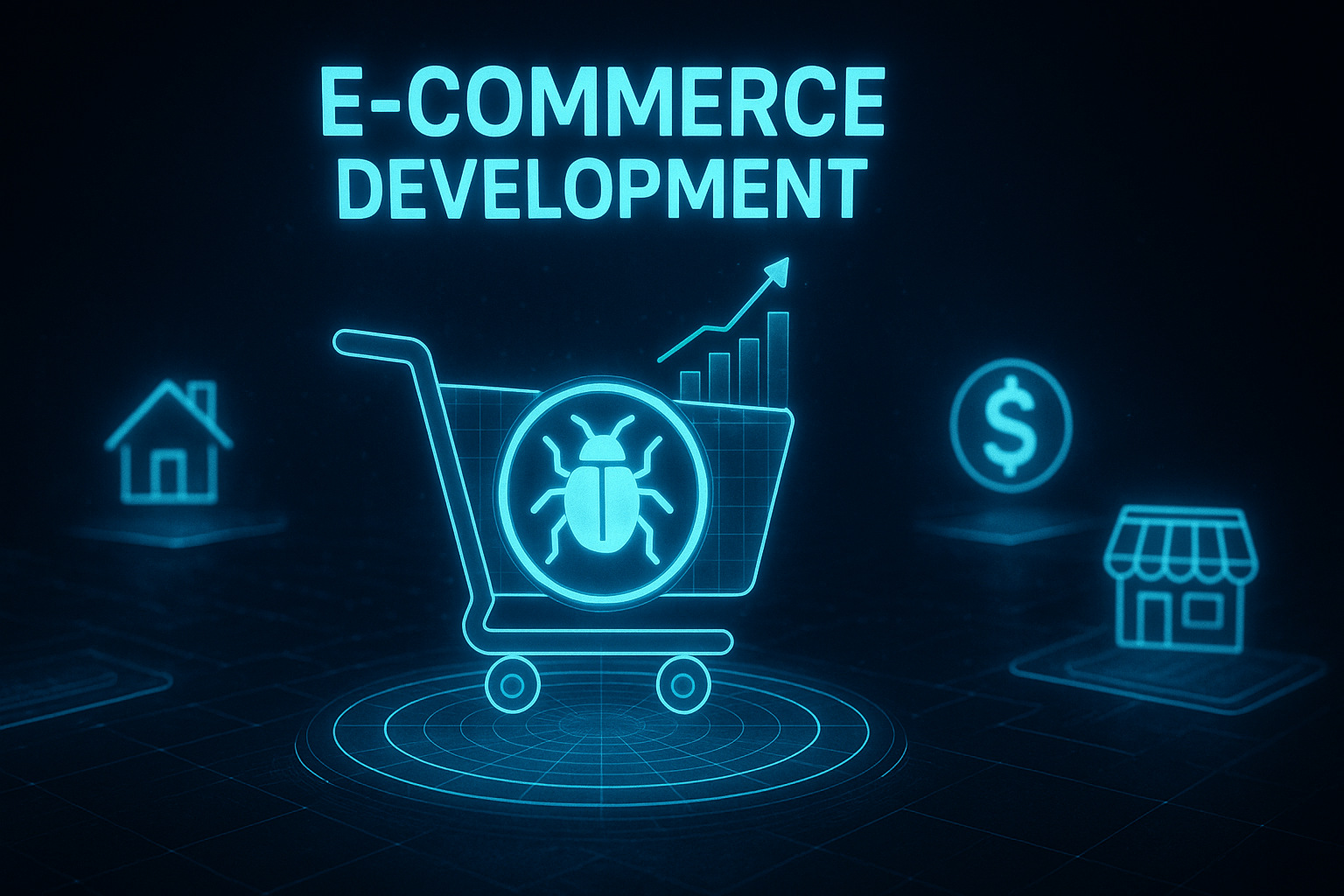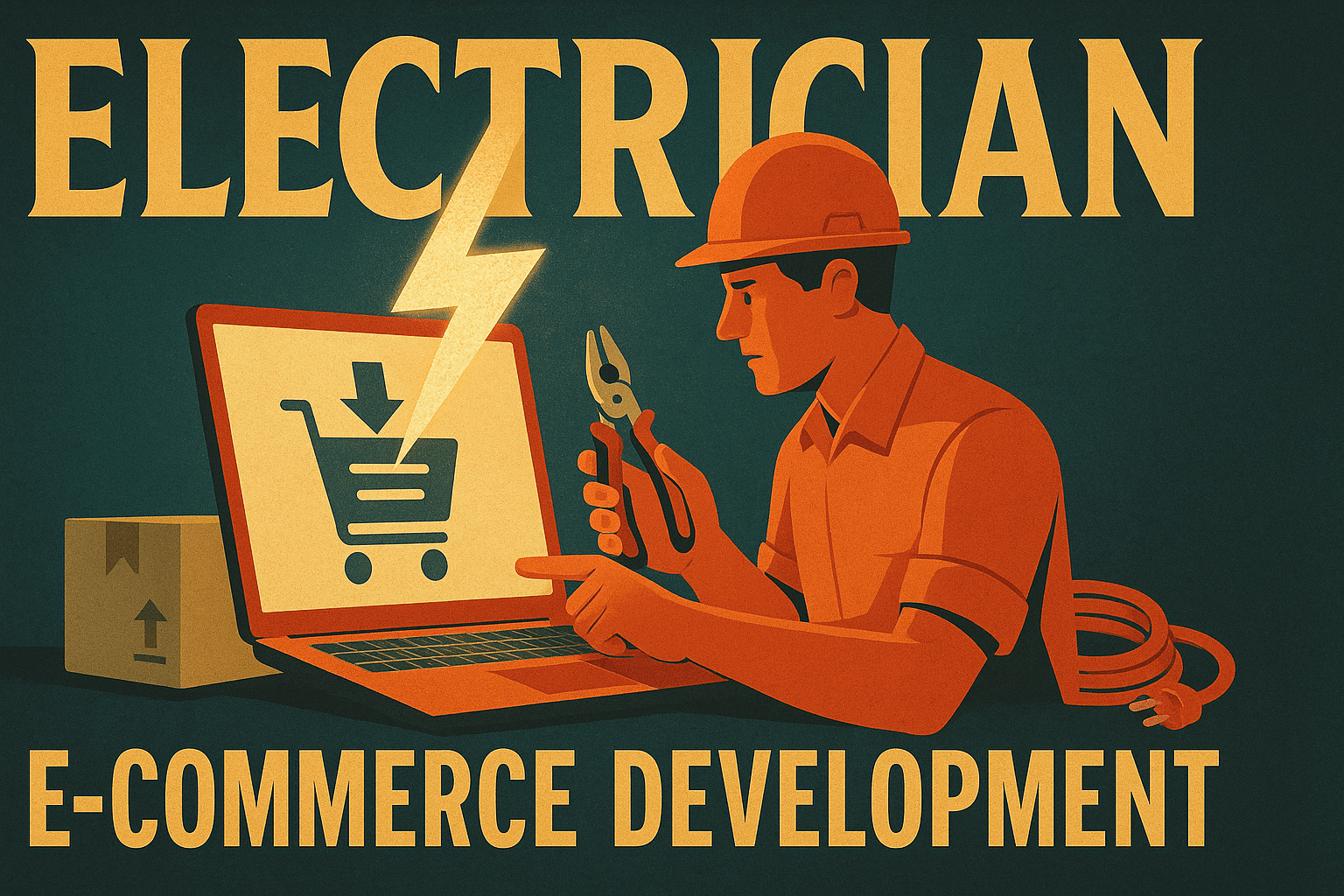Complete Guide to E-commerce Development for Pest Control Companies in 2026
by Design Delulu Editorial · October 13, 2025

The pest control industry is experiencing a digital transformation. Homeowners and businesses increasingly prefer researching solutions, comparing products, and purchasing pest control services online before ever picking up the phone. If your pest control company lacks a robust e-commerce platform, you're leaving revenue on the table and losing ground to competitors who meet customers where they are.
E-commerce development for pest control isn't just about throwing products on a website. It requires strategic planning around seasonal demand fluctuations, subscription models for recurring treatments, geographically-targeted service offerings, and compliance with regional pesticide regulations. The right e-commerce platform converts casual browsers into paying customers while automating quote requests, service scheduling, and product fulfillment. This guide walks you through everything from foundational requirements to advanced optimization strategies that top pest control companies use to dominate their markets.

Why Pest Control Companies Need Specialized E-commerce Solutions
Generic e-commerce platforms fall short for pest control businesses because they don't account for the unique complexity of selling both products and services simultaneously. A homeowner might purchase DIY ant traps while also requesting a professional termite inspection. Commercial clients need bulk pricing for warehouse fumigation supplies plus the option to schedule recurring quarterly treatments. Traditional online stores can't elegantly handle this hybrid model without extensive customization.
Pest control e-commerce must address seasonal volatility. Mosquito control products spike in summer, rodent solutions peak in fall and winter, and termite services surge in spring. Your platform needs dynamic inventory management, seasonal promotions automation, and predictive analytics to optimize stock levels and marketing spend throughout the year. Without these capabilities, you'll face stockouts during peak seasons and excess inventory during slow periods.
Regulatory compliance adds another layer of complexity. Different states have varying requirements for pesticide product labeling, applicator licensing disclosures, and service area restrictions. Your e-commerce system must automatically display appropriate disclaimers, restrict certain products based on shipping addresses, and integrate with your licensing database to ensure technicians are certified for the services they're dispatched to perform. These aren't nice-to-have features—they're legal requirements that protect your business from liability.
The subscription model that many pest control companies rely on for predictable recurring revenue requires sophisticated billing logic. Customers expect flexible payment options, easy plan modifications, seasonal pause capabilities, and transparent pricing that adjusts based on property size and treatment frequency. A well-designed e-commerce platform automates these subscription complexities while providing self-service portals that reduce call center volume and improve customer satisfaction.
Core Features Every Pest Control E-commerce Platform Needs
High-converting product detail pages (PDPs) for pest control require more than standard e-commerce templates. Customers need educational content explaining what pests the product targets, application instructions, safety information, and expected results timelines. Including comparison tables, before-and-after imagery, and video demonstrations significantly increases conversion rates. Your PDPs should also feature prominent calls-to-action for professional service upgrades when DIY products may be insufficient for severe infestations.
Service pages function differently than product pages but are equally critical. They must clearly communicate your service offerings, treatment methodologies, pricing structures, and service area coverage. Interactive elements like zip code checkers for instant service availability, inspection scheduling widgets, and instant quote calculators reduce friction in the buyer journey. Integration with your routing and scheduling software ensures that booked appointments flow directly into technician calendars without manual data entry.
The checkout experience makes or breaks conversion rates. Pest control checkout flows must accommodate multiple payment types including one-time purchases, subscription signups, deposit payments for scheduled services, and split transactions that combine products with services. Guest checkout should be available for product purchases while encouraging account creation for service customers who benefit from service history tracking and easy rebooking. Mobile optimization is non-negotiable since over sixty percent of pest control searches happen on smartphones.
Search and filtering capabilities must account for how customers think about pest problems. Customers rarely search by product name; they search by pest type, treatment location, problem severity, or desired attributes like pet-safe or organic. Your site architecture should support faceted search filtering by pest category, indoor versus outdoor use, residential versus commercial application, and treatment method. Intelligent search that understands synonyms and common misspellings prevents frustrated customers from abandoning your site.

Merchandising and Revenue Optimization Strategies
Strategic product bundling dramatically increases average order value in pest control e-commerce. Creating solution-oriented bundles like 'Complete Ant Defense Kit' or 'Seasonal Mosquito Control Package' encourages customers to purchase comprehensive solutions rather than single products. These bundles should offer modest savings compared to individual item purchases while ensuring customers have everything needed for effective treatment. Subscription bundles that deliver refills on a schedule work particularly well for ongoing pest prevention.
Cross-selling and upselling opportunities exist throughout the customer journey. Product pages for DIY solutions should prominently feature professional service options for customers who prefer expert application. Cart pages can suggest complementary products—bait stations with rodent attractants, sprayers with liquid pesticides, protective gear with chemical treatments. Post-purchase email sequences should introduce related products and remind customers when reapplication or follow-up treatments are recommended based on their purchase history.
Dynamic pricing strategies help maximize revenue while remaining competitive. Implement geographic pricing adjustments based on local market conditions and competitor rates. Offer volume discounts for commercial customers and property management companies ordering at scale. Create time-sensitive promotions tied to seasonal pest activity surges. Abandoned cart recovery campaigns with progressive discount offers can recapture twenty to thirty percent of lost sales when executed properly with the right messaging cadence.
Membership and loyalty programs create competitive moats around your business. Pest control customers who subscribe to protection plans demonstrate significantly higher lifetime value and retention rates than one-time service customers. Structure membership tiers that provide increasing benefits like priority scheduling, discounted additional services, free reinspections, and exclusive access to premium products. Points-based loyalty programs encourage repeat purchases and generate valuable data about customer preferences and buying patterns.
Technical Performance and Scalability Considerations
Page load speed directly impacts conversion rates, with research showing that every one-second delay reduces conversions by seven percent. Pest control e-commerce sites must implement comprehensive performance optimization including image compression, lazy loading for below-the-fold content, code minification, content delivery networks, and efficient database queries. Large product catalogs with thousands of SKUs across multiple categories require careful indexing and caching strategies to maintain fast search and filtering response times.
Mobile performance deserves separate attention beyond responsive design. Mobile users exhibit different browsing patterns and have less patience for slow-loading pages. Implement accelerated mobile pages for product listings and informational content. Ensure touch targets are appropriately sized and spaced for thumb navigation. Simplify mobile checkout to minimize form fields and take advantage of autofill capabilities. Progressive web app capabilities like offline browsing and add-to-homescreen functionality can significantly improve mobile engagement metrics.
Security and data protection are paramount when handling customer payment information and personal details like home addresses. Implement SSL certificates across your entire domain, not just checkout pages. Use tokenization for payment processing to avoid storing sensitive card data. Regularly update your platform and all plugins to patch security vulnerabilities. Conduct penetration testing and security audits annually. Display trust badges and security certifications prominently to reassure customers that their information is protected.
Scalability planning ensures your platform handles traffic spikes during peak seasons without crashes or slowdowns. Architect your infrastructure to scale horizontally, adding server capacity during high-demand periods and scaling down during quiet seasons to control costs. Implement proper load balancing, database replication, and caching layers. Conduct stress testing before major promotional campaigns to identify bottlenecks. Cloud-based hosting solutions offer the flexibility most pest control businesses need to handle variable traffic patterns cost-effectively.
Analytics, Tracking, and Continuous Improvement
Comprehensive analytics instrumentation is the foundation of e-commerce optimization. Implement event tracking for all critical user interactions including product views, add-to-cart actions, checkout initiations, and purchase completions. Set up enhanced e-commerce tracking to capture detailed product performance data, cart abandonment patterns, and revenue attribution by source. Track micro-conversions like quote requests, phone calls, and service area checks that may not immediately result in online purchases but indicate commercial intent.
Customer cohort analysis reveals valuable insights about behavioral patterns and lifetime value trajectories. Segment customers by acquisition channel, first purchase category, service versus product preference, and geographic location. Track cohort retention rates, repeat purchase frequency, and average order value progression over time. This data informs targeting strategies, retention initiatives, and product development priorities. Identifying your highest-value customer segments allows you to allocate marketing resources more efficiently.
Conversion funnel analysis pinpoints exactly where potential customers drop off in their journey. Examine exit rates on key pages, form abandonment patterns, and checkout friction points. Use session recording tools to watch how real users interact with your site and where they encounter confusion or frustration. A/B testing different layouts, copy variations, and call-to-action placements provides empirical evidence about what drives conversions. Even small improvements compound significantly when applied to high-traffic pages.
Attribution modeling helps you understand which marketing channels drive the most valuable customers. Pest control buyers typically research extensively before purchasing, touching multiple channels during their decision journey. Implement multi-touch attribution that credits all touchpoints rather than only first-click or last-click models. Track assisted conversions to understand how channels like content marketing and social media contribute to sales even when they're not the final touch. This intelligence prevents you from underinvesting in valuable top-of-funnel channels that don't get credit in simplistic attribution models.

Implementation Roadmap and Timeline Expectations
The discovery phase establishes project parameters, success criteria, and technical requirements. This involves stakeholder interviews, competitive analysis, customer research, and technical infrastructure assessment. We document your business goals, budget constraints, timeline requirements, and integration needs with existing systems like your CRM, scheduling software, and accounting platforms. Clear upfront requirements prevent scope creep and ensure all parties share aligned expectations throughout the project.
The blueprint phase translates discovery insights into detailed specifications. This includes information architecture that maps all page types and user flows, wireframes showing layout and functionality for key templates, technical architecture documenting how systems integrate and data flows between platforms, and a measurement plan defining all tracked events and conversion goals. Design mockups bring visual identity to the wireframes while maintaining usability principles. Detailed specifications enable accurate development estimates and reduce ambiguity during implementation.
The build phase brings designs to life through iterative development sprints. Front-end development creates pixel-perfect implementations of approved designs with responsive behavior across devices. Back-end development builds the business logic, database architecture, and API integrations that power the platform. Rigorous quality assurance testing happens continuously, not just at the end—we test functionality, cross-browser compatibility, performance benchmarks, and security vulnerabilities. Staging environment reviews allow stakeholders to interact with working features before final deployment.
The launch phase involves careful preparation and contingency planning. Content migration transfers existing products, descriptions, images, and metadata to the new platform. Data validation ensures accuracy and completeness. DNS configuration, SSL certificate installation, and analytics implementation happen according to a detailed launch checklist. We typically launch to a small percentage of traffic initially, monitoring performance and user behavior before directing all visitors to the new platform. Post-launch support addresses any issues that emerge with real-world traffic and usage patterns.
Best Practices
- Prioritize highest-impact pages and flows first. Focus development effort on home page, category pages, top product pages, and checkout before optimizing less-visited sections.
- Pair creative with measurement so every asset has a KPI. Beautiful design means nothing without conversion data proving it drives business results.
- Use templates and component systems to scale quickly. Well-designed templates maintain consistency while allowing rapid page creation without starting from scratch.
- Close the loop with weekly reviews and quarterly resets. Regular performance reviews identify what's working and what needs adjustment while quarterly strategic planning ensures alignment with evolving business goals.
- Optimize for mobile first, then enhance for desktop. The majority of pest control searches start on mobile devices, making mobile experience the priority.
- Implement robust search functionality with autocomplete. Customers who use search convert at higher rates; make search prominent and effective.
- Create compelling product descriptions with educational content. Customers want to understand what they're buying and how to use it effectively.
- Use high-quality imagery showing products in use. Before-and-after photos and application videos significantly improve conversion rates.
Industry-Specific Tips for Pest Control
- Map search intent to pest control buyer stages. Early-stage researchers need educational content; late-stage buyers need clear pricing and booking options.
- Use social proof and outcomes early in the journey. Customer reviews, success stories, and treatment effectiveness statistics build trust and credibility.
- Measure against a single source of truth dashboard. Consolidate metrics from multiple platforms into one executive view preventing conflicting data interpretations.
- Ship small, test fast, keep compounding wins. Incremental improvements tested and validated accumulate into significant competitive advantages over time.
- Feature seasonal content prominently during relevant periods. Surface mosquito solutions in spring, rodent control in fall, maintaining relevance to current customer concerns.
- Offer flexible service scheduling with instant availability confirmation. Customers expect immediate booking confirmation, not callbacks or delayed responses.
- Highlight licensing, certifications, and insurance prominently. Professional credentials differentiate you from unlicensed competitors and build customer confidence.
- Create content addressing common pest concerns in your service area. Local SEO content targeting regional pest issues drives qualified traffic.
Frequently Asked Questions
Let’s level up your Pest Control business
Need services that actually move the needle for Pest Control? See our approach, pricing, and timelines—then book a quick call.
Additional Resources
- Schedule a Consultation
Book a complimentary strategy session to discuss your pest control e-commerce needs. We'll review your current challenges, explore potential solutions, answer questions about our process and pricing, and determine if we're the right fit to help you achieve your digital commerce goals.
- View Our Portfolio
Explore successful e-commerce projects we've delivered for pest control companies and other service-based businesses. See real examples of conversion-optimized platforms, custom integrations, and results-driven implementations that demonstrate our approach to building revenue-generating digital experiences.
- Free Marketing Tools
Access our collection of free tools designed for pest control businesses including ROI calculators, conversion rate benchmarking resources, SEO audit templates, and e-commerce readiness assessments. These resources help you evaluate opportunities and make informed decisions about your digital strategy investments.
Related Reading

Professional e-commerce development for photographers & videographers. Sell prints, packages & digital downloads with optimized product pages, smart checkout flows & analytics that track what sells.

E-commerce development for fashion retail that drives conversions. Get optimized PDPs, streamlined checkout, merchandising strategies, and analytics. See results in 4-8 weeks.
